The winter season can be really hard on your dog’s paws. So today I thought I’d write about a couple of tips for taking care of your dog’s paws in the winter. These tips will help protect the paws from ice, snow, and salt.
The main solution is to protect the paws from ice and salt. This can be done by regularly cleaning the paws and making the dog wear booties when going outside.
For solutions to protecting dog paws in winter, scroll a little bit down. The first part of the article is about potential problems that can occur in winter.
When the weather becomes colder, it’s vital to take precautions whenever you are walking your dog to ensure that your dog’s paws are comfortable and safe. Just like you feel the cold, so will your canine friend.
We have frigid weather from November to February. I really felt it was important to share a few tips on how to take care of your dog’s feet in cold winter weather.
The first thing you might notice when you’re outside with your dog is that they start walking funny. They would start doing hitching behavior, holding a pop, or conversely, they’re laying down.
They’re laying down on the ground, and it just seems so strange because the snow is so icy cold. Your dog is probably doing that in response to having really cold feet.
Ice stuck between the paws of a dog will cause discomfort, and the antifreeze salt can be dangerous to dogs.
Although we don’t get a lot of snow each year, when we get it, we should ensure that our fur friends are properly cared for.

If ice sticks between the paws of your dog, it is pretty uncomfortable for them and can lead to discomfort when walking.
The snow also attaches to the hair of the dog and then melts because of their body heat.
That might form ice balls which will then push the toes of your dog apart and bring lots of discomfort due to pulled hair and cracking.
Two Deadly Problems to Dog Paws in Winter
In severe cases, your dog could also get two serious conditions if it is in the snow or ice for a long time or the snow is not removed. These conditions include:
- Frostbite
- Hypothermia
Frostbite
Prolonged exposure to pretty cold temperatures can cause the body of your dog to constrict blood vessels near the skin to keep the essential body temperature stable.
However, in extreme conditions, this can reduce the flow of blood to extremities.
The reduced blood flow along with the cold temperatures can lead to irreparable damage to the frozen tissues, and this is why frostbite should be treated immediately.
Cong-elation or frostbite occurs when prolonged contact to incredibly cold temperatures occurs. Most commonly affected parts in a dog’s body are ears, nose, nipples, scrotum, and tail.
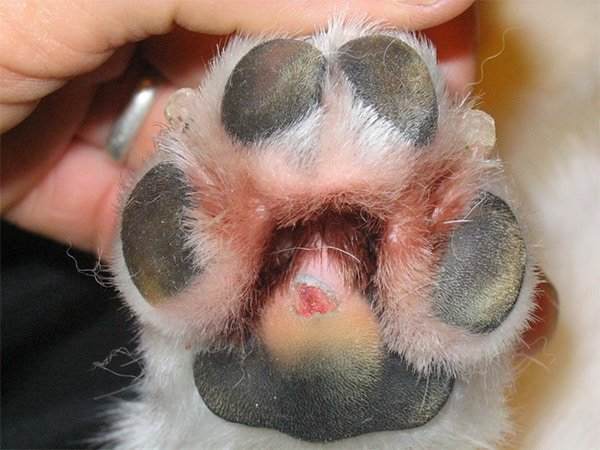
Hypothermia
Hypothermia in pets is an extreme lowering of body temperatures. It happens when dogs suffer contact to cold temperatures for a long time, or if they have wet hair in cold, and windy areas.
When the temperature of the body drops, the breathing and heart rate slows down, and this can cause several complications.
The consequences of prolonged, severe hypothermia might include heart problems, neurological problems, frostbite, slow or no breathing, kidney failure, and eventually death.

Tips for Caring for Dog Paws in Winter
#1 Taking Short Dog Walks
The dogs left in the frigid weather for long periods are at the risk of getting hypothermia and frostbite on the paws. According to animal experts, dogs should not spend many hours in the cold.
Regular short walks in winter are better for your puppy than one long walk. Also, avoid walking your pet in the dark to prevent them from any potential dangers at night when things are not clear.
#2 Look for Routes That will Keep Your Dog Safe
Apart from protecting the paw pads of your dog, you should look for wooded spaces when taking winter walks with your puppy because they are full of scents, as well as protection from unfreezing salts and wind.
By doing this, you will make your walks more comfortable and safer because your dog will be free of any dangers encountered when walking on streets and sidewalks.
#3 Maintain a Pet-Friendly Yard During Winter
Winter brings new challenges for dog owners, since the pets who spent most of the time outdoors get cooped up inside. Nevertheless, with some creativity and careful thought, you can maintain the outdoor fun for your dog even during the cold seasons.
Have a space in your yard that is a bit sheltered from the snow, wind and other elements. If your pet is sensitive to cold, select an outdoor area that provides additional protection.
Also, limit the time your canine friend spends outdoors as well to avoid problems like hypothermia.
#4 DIY Paw Protector for Protection in Extreme Cold
You can make a DIY paw protector made with all-natural ingredients, it’s super easy to make. It’s really a great way of maintaining the moisture in your dogs paws.
By using it, you are protecting their feet from some of this inclement weather.
#5 Clean the Snow That Gets Stuck in Their Paw
But there are a few other things that I’d like to talk to you about. First up is prevention. A lot of dog breeds have really hairy toes. It’s no surprise that when they’re out in the cold, snow gets trapped in between there.
A really simple way to minimize the amount of snow and ice that can get trapped in there is by trimming the fur in between your dog’s toes.
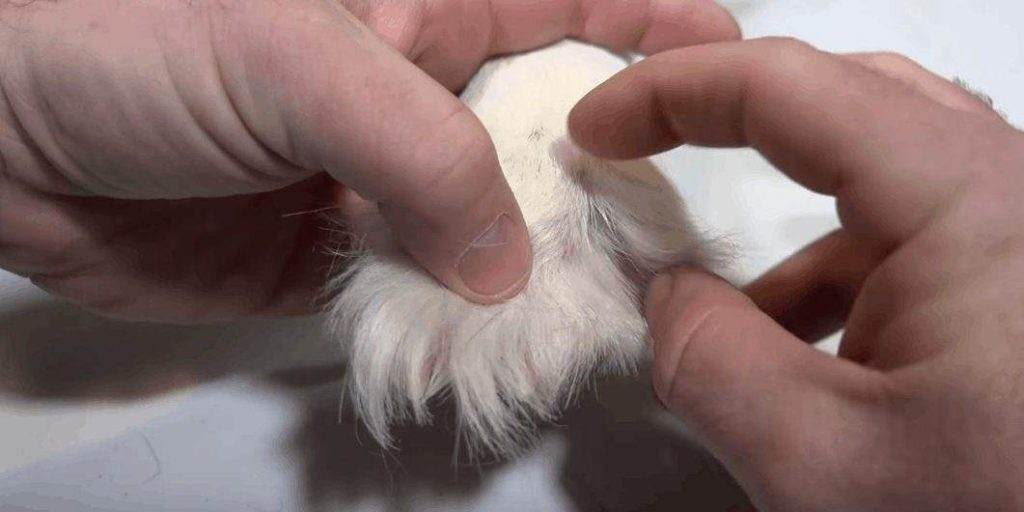
It’s worth noting that if you have a dog like a Labrador Retriever or a Nova Scotia Duck Tolling Retriever or a Portuguese Water Dog, your dog has webbed feet. This means that they’re even more likely to be trapping snow in between their toes.
In the cases mentioned above, you need to pay extra attention to dogs of that breed. They are way more likely to be trapping snow than some of the other breeds.
The easy solution is that you can trim the hair away from the webbing. But you still need to be extra aware with those breeds of dog, any dog with webbed feet.
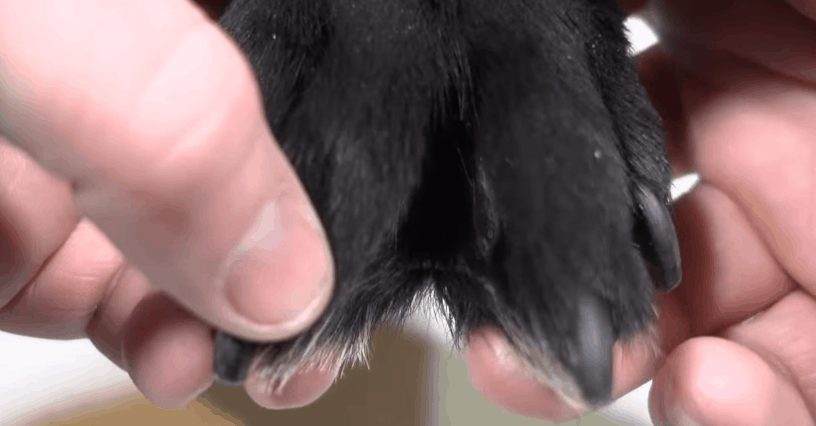
#6 Use the De-icing
The public places are full of the deicing methods, whether it’s salt or brine or whatever. When you are outside with the dog and there is an emergency, you should use those services.
Snow is all over our walkways and our parking lots and our streets. You never know when your dog can really start to feel un-comfortable and these de-icing services can be of help in those times.
#7 How to Clean Snow from Paws
There is another tip for you when you’re walking your dog in any places with snow. On reaching home, clean their paws off. Some people will keep a bowl of water by the door to wash the paws. Preferably something that’s a wide base so it’s less likely to tip.
When your dog is going inside, you can dip each one of the dog’s feet in there. You can inspect them thoroughly, and then dry them off before bringing the dog inside.
If you want a product that is made to make your life easy then check the dog paw cleaner here on Amazon.
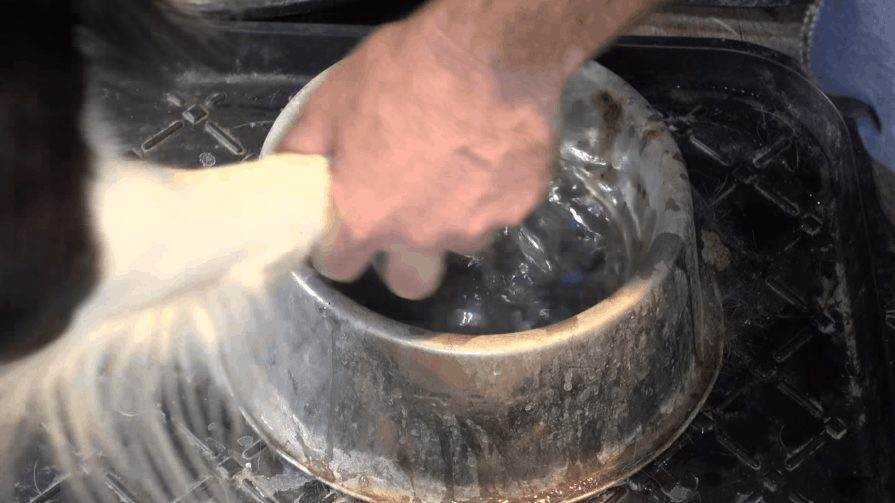
I prefer the method where I have like a washcloth or even a heavy-duty paper towel. I’ll run some warm water on it, and I’ll clean each of the dog’s feet when they get inside.
Cleaning the paws is important because that salt in the snow can really do some damage on your dog’s feet.
There’s just so much of the salt in these public places that you really wanna make sure that it’s off your dog’s feet when they do come in the house.
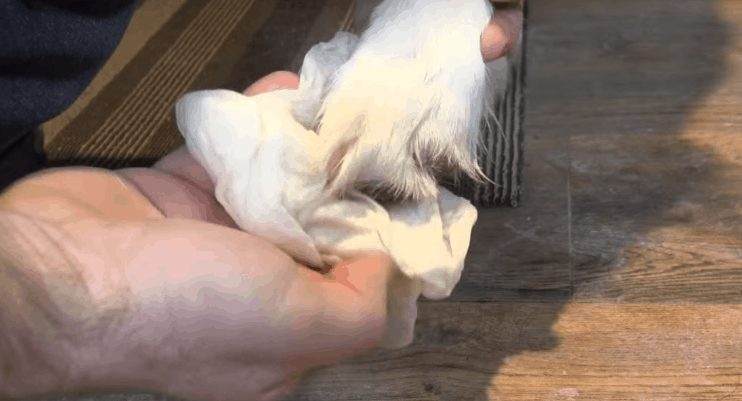
A quick and to the point video showing how exactly to do it is:
#8 Taking a Close Look On Nails
Since you’re doing all these foot inspections this time of year, it’s a good idea to keep an eye on your dog’s nails.
Something people don’t realize is that when a dog’s nail grows too long, it actually changes the way that they walk.
And in the cold weather, when it’s really cold, and the salt, and the ice, and it’s really nasty outside, changing the way that your dog walks puts unusual pressure on their foot. This can really damage their pads.
So this is a great opportunity to be hyper-vigilant about making sure that your dog’s nails are trimmed.
If you want to know the correct way to trim dog’s nails then I have an article on The #1 Guide to Use Dog Nail Clippers.
#9 Using Dog Shoes or Booties
There’s always the alternative of booties. Now we’re looking after a couple of dogs this week that use booties when they go outside.
They’re pretty sensitive to the cold. I know a lot of people who have tried booties and they thought, oh my dog hates them.
But the reality is that for the dogs, it’s like wearing a new pair of glasses. When you wear glasses, you really notice they’re on your eyes at first but you’re constantly fussing with your glasses until you just get used to them. From my experience, these dog shoes would be a good choice.
So when you try on a pair of booties on your dog for the first time, make it a really relaxed environment and a really rewarding experience.
Do it somewhere where it’s really low energy, low stress, lots of reward for your dog, they will stop fussing with those booties.
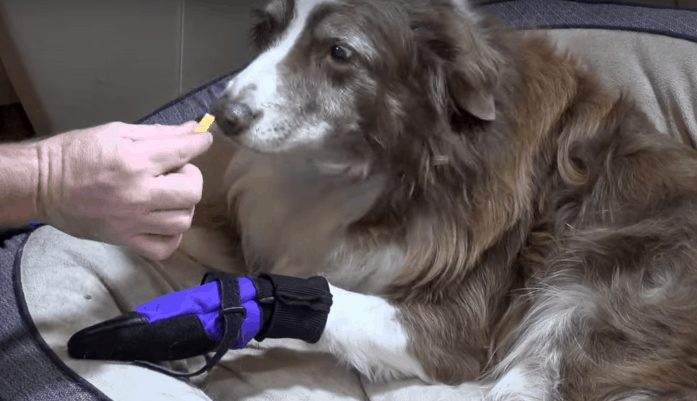
The last thing you want to do though is slip those booties on and throw on your leash and then head out the door for a big walk. As with everything, it takes time for your dog to get accustomed to them.
So really take your time, and make your dog comfortable with the booties before you challenge them with the outdoor environment.
If you see your dog showing any signs of hitching or walking strangely or even lying down, it’s time to scoop them up, and let your dog use the booties indoors.
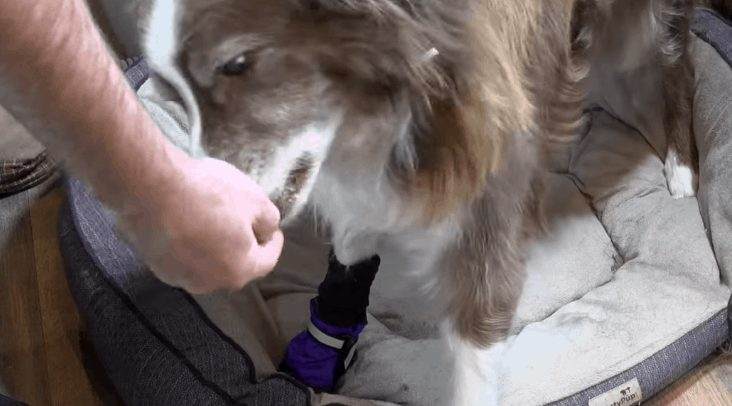
Learn More With the Help of Video
Other safety tips for dogs in winter
- Avoid using antifreeze salts in your yard because they can easily poison your dog.
- Avoid leaving your dog outdoors for a long time in cold temperatures.
- Be careful when walking your dog on ice during winter to prevent falls and slips that are common during this season.
- Keep your dog’s food and water indoors to prevent it from freezing.
- Before heading out during winter, it’s good to consider if your dog’s breed can withstand the weather outside. Some breeds are made to run in the snow, while others require some form of clothing during chilly months.
Conclusion – Protect Dog Paws from Snow, Ice and Salt
Taking quiet walks when the snow is falling and playing fetch-the-snowball, leaping through fluffy drifts are just some of the best reasons why winter season can be an exciting time for you and your canine friend.
However, these activities can wreak havoc on the paws of your dog as well. While pet paws are more resilient than human feet, they also have their limits. You can keep your dog paws healthy and safe in winter using these simple dog care tips.
This article was about winter care, if you also want to take a look at summer-related caring for your dog then check the article on 14 Hot Tips for Dog Owners in Summer.
We’ve posted all kinds of articles about trick training and fun things to do indoors with your dog. So, I would really lean on those exercises to get your dog both physically and mentally stimulated and exercised.
But keep the outside play sessions a little bit shorter. A lot of dogs are really sensitive to the cold and you need to keep that in mind.
References
- https://www.vetsmall.theclinics.com/article/S0195-5616(06)00021-0/abstract
- https://hal.archives-ouvertes.fr/hal-01191154/file/JPET%20-%20E%20J-%20pk,pd%20-%202011_%7BCEB93B89-E335-4764-B94C-8844DB45ADE7%7D.pdf
- https://baskina.com/wp-content/uploads/2012/10/practioner-guide-working-dog.pdf
Table of Contents
